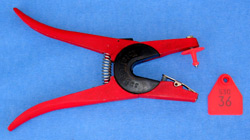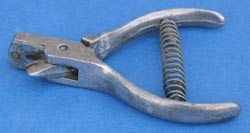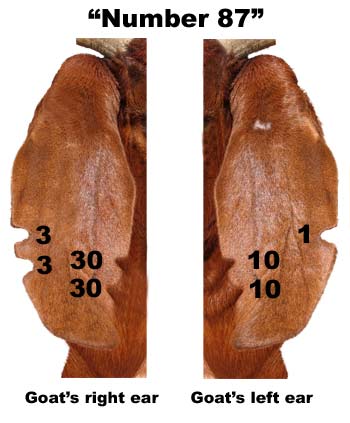The proper identification of animals is essential. Proper identification enables the producer to keep comprehensive records for milk production, reproduction, health problems, and management practices. The efficient maintenance of this information requires a permanent identification system. Several systems of identification may be used. The system selected will depend upon the size of the herd, the environmental conditions, the primary purpose for identifying individual animals, and regulations of federal government and breed-governing bodies. There are two basic types of identification: permanent and non-permanent. Permanent identification includes tattooing, ear notches or microchips. Non-permanent identification includes paint, chalk and tags.
Tattooing
Tattooing is one method of identification that is permanent if properly done. However, it is not easily viewed and may require another complementary method of identification, such as an ear tag, that is visible from short distances. Tattooing involves making needlelike projections in the goat’s skin. The tattoo ink is forced into the punctures and remains visible after the puncture wounds heal. It is a good idea to sterilize the equipment and clean the goat’s ears to help prevent the spread of some blood-borne diseases. On older animals some tattoos may be difficult to read; holding a bright light source such as a flashlight behind the ear when reading may make the tattoo more legible.
To tattoo an animal, begin by inserting the proper digits into the tattoo pliers. Check for correctness by pressing the pliers onto a piece of paper or cardboard. Secure the goat with a halter or head gate and clean the ear to be tattooed with alcohol. Don’t use water for cleaning as it could enter the ear canal and result in infection. Clip or trim any excessive hair present. A generous amount of ink should be applied to the center of the ear between the ribs of cartilage (green ink should be used for dark ears). Position the tattooing pliers between the ribs of cartilage and squeeze firmly forcing the needle-like numbers into the ear tissue. Care should be taken in removing the tattoo pliers from the ear to not scratch the tattooed area. Ink should be reapplied and rubbed into the tattoo. Using an old toothbrush will assist in pushing the ink into the punctures. Afterwards, the equipment and individual tattoo pieces should be cleaned and sprayed with alcohol.
Ear tags
Ear tags are an easy way to permanently identify each goat in the herd. Unlike tattoos, they can be read without actually having to catch the goat. Unfortunately, unlike tattoos, they can break or be ripped out of the goat’s ear. Some producers use two ear tags because of this problem. Goats that are shipped are required to have a scrapie ear tag and these can be used for animal identification. Before putting in the ear tag, it is important to record what ear tag number is assigned to the goat. Ensure the ear tags are inserted between the cartilage ribs on the ears. The producer whose goats have been ear tagged will have an easy-to-read identification number which can be used for herd records.

Microchip
The insertion of a microchip in the base of the ear or tail web of the animal is another form of permanent identification. After insertion, the microchip should be scanned to ensure that it is reading correctly. Care should be taken in recording the microchip number against the tag number of the animal to ensure the integrity of the microchip identification. Exhibitors are required to provide their own reader at many livestock shows.
Ear notching
Ear notching is commonly practiced in identifying goats. It has the advantage of being visible from a distance allowing identification without the necessity of catching the animal and can accommodate numbers up to 9999. An ear notching pliers are used to put “V”-shaped notches in the edges of the ear and a hole punch is used to punch holes in the middle of the ear, if necessary. The animal is restrained and notches and holes may be treated with iodine. As this process results in bleeding, the notching pliers should be disinfected between animals to prevent transmission of any blood-borne diseases. The notching system used is that begun in the Angora industry and adapted for meat goats. However, some producers may use alternate numbering system. Generally, notches on the goat’s left ear mean: 10 (top), 1 (bottom), 100 (end); and 1,000 (center hole). On the goat’s right ear, notch values are: 30 (top), 3 (bottom), 300 (end); and 3,000 (center hole). Thus, a goat with the number 135 would look as follows: 1 notch on end of left ear (100); 1 notch on top of right ear (30), 2 notches on bottom of left ear (2); 1 notch on bottom of right ear (3) with a total value equaling 135.


Next
Module Home
Certification Table of Contents
Browsing Table of Contents
